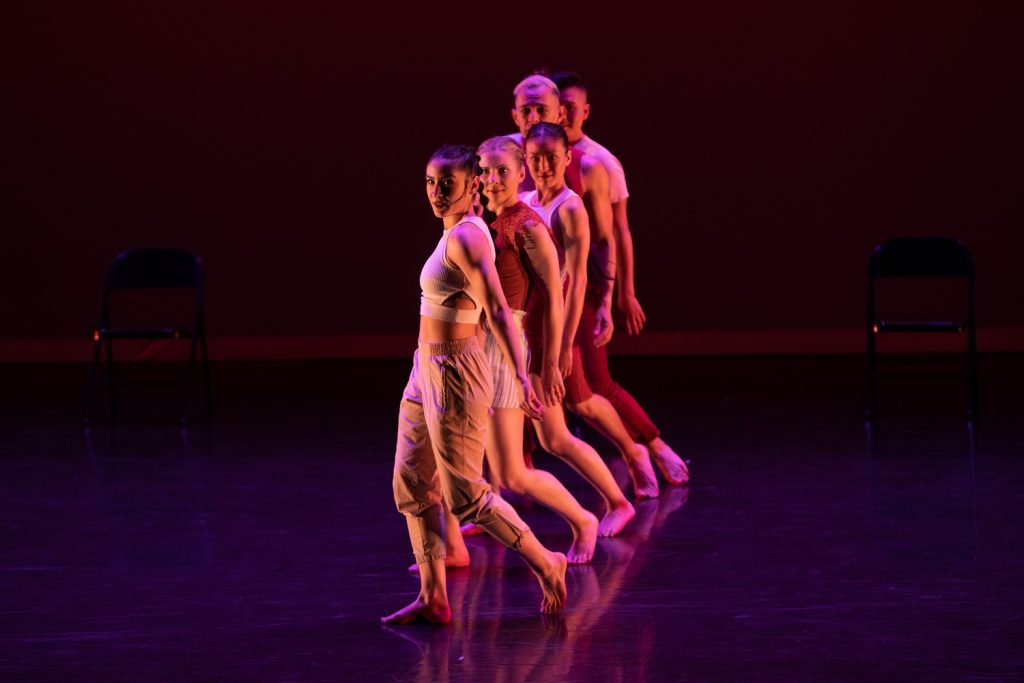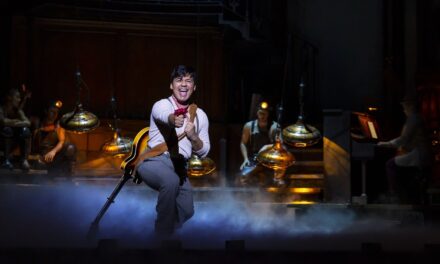After three years of COVID shutdowns, Saturday, May 6, 2023, marked the return of the So Cal Dance Invitational produced and curated by Nannette Brodie at the Martha B. Knoebel Dance Theater. Located in the CSU, Long Beach Dance Center, the Martha B. Knoebel, with its large stage and 230 seat house, was the perfect setting for viewing the four very different local dance companies. BrockusRED and Nannette Brodie Dance Theatre are based in Los Angeles County and FUSE Dance Company and Jazz Spectrum Dance Company call Orange County their home.
TREE is an excerpt of a longer and powerful environmental work titled DUST by choreographer, producer, curator, and artistic director of BrockusRED, Deborah Brockus. The work investigates the results of climate change on Mother Earth and her inhabitants. In TREE, Brockus, whose work is rooted in modern dance, utilizes the movements and shapes of barren trees. For this viewer, this performance was one of the best yet. Her commanding BrockusRED company members Mara Hancock, Denali Huff, Jack Ironstone, and Julienne Mackey held together to bring Brockus’ choreographic vision into a striking visual reality.
Hancock was gorgeous in her opening solo which introduces the main theme of the work. First seen in silhouette against a projection of dead trees in a barren landscape, Hancock’s arms represent the tree limbs and her torso and legs its trunk. As the work progresses, it becomes a high energy abstract painting in motion depicting the relationship of humans and nature.
The music for TREE was by Omar Faruk Tebilek and Cheb / Sabbah, costumes and video by Brockus, and the Lighting Designer was Jody Caley.

Jazz Spectrum Dance Company – Alfonso Fuentes, Janell Burgess, Karli Padilla in “Midnight Blues’ – Photo by Denise Leitner
MIDNIGHT BLUES part 2 was originally choreographed by the founder of the Jazz Spectrum Dance Company, Christine Baltes in 2000 and re-created and choreographed by the current artistic director Janell Burgess in 2022. This was the second time in the past month that I have seen this work, and while the three dancers Janell Burgess, Alfonso Fuentes, and Karli Padilla are quite wonderful and capable performers, the work still came across as flat. This second viewing made me realize that what bothered me was that the choreography is not as emotionally or rhythmically intricate as Miles Davis’ extraordinary music. Baltes and Burgess missed the chance to work in, around, against, and outside the multiple levels of musical colors that Davis painted. While the work was entertaining at times, it lacked subtlety in the movement’s delivery.
The Costume Designer for MIDNIGHT BLUES was Tomo Swan and the Lighting Designer was Lenny Lindsey.

FUSE Dance Company – Leann Alduenda, Phillip Lu, Stephani Lin Ocampo, Joshua D. Estrada-Romero, Julia Rae Mdoran in “AlphA:ArenA” – Photo by Denise Leitner
Joshua D. Estrada-Romero, artistic director of FUSE Dance Company, can be relied on to provide high powered, beautifully performed dance works, and while the ending felt odd, AlphA: ArenA definitely delivered. Also rooted in modern dance, Estrada-Romero is a master of choreographic structure. He understand how to direct the audience’s eye, how and when to use unison phrases. Another one of his strengths is his choices of music. In this work it was the music of Christof Littman that drove the dancers forward.
Rotating in and out of a circle of dancers with the alpha-want-to-be in the center, the work illustrated the group’s need of a leader, the desire to be the top dog, and the perils of that power struggle. Here, the unison was used to bring together the followers within the pack. It made sense as opposed to simply putting movement phrases together at random.
The very talented cast of AlphA: ArenA included Leann Alduenda, Joshua D. Estrada-Romero, Phillip Lu, Julia Rae Moran, and Stephani Lin Ocampo. The basic black costumes were by Estrada-Romero and the eerie but arresting lighting was by Jody Caley.

BrockusRED – Jack Ironstone, Julienne Mackey, Denali Huff, Mara Hancock in Brockus’ “City” – Photo by Denise Leitner
BrockusRED then presented another excerpt of a longer work, CITY (from EDGE OF THE SANDS). Backed up by projections of sand dunes that first appeared as a fluttering sheet moving across the back wall before shifting into scenes of beautifully designed desert city buildings, the cast of four were dressed in gorgeous matching decorative red dresses that billowed out as they spun like whirling dervishes. Inspired by the music by Phil Thorton, Hossam Ramzy, and David Holland, Brockus provided a sensual expression of what the people of middle east have to offer.
The dancers who awed us with their spinning were Mara Hancock, Denali Huff, Jack Ironstone, and Julienne Mackey. The costumes were by Deborah Brockus and the lighting was by Jody Caley.

Jazz Spectrum Dance Company – Estelle Verdugo and Karli Padilla in “Treat” – Photo by Denise Leitner
The original concept for TREAT (Part 3 of SANTANA SUITE) was by Baltes in 1997 and choreographed by Burgess in 2021. The movement in this work was charming, lively and beautifully performed to the music of Santana, but truthfully, it was a duet with two dancers, Janell Burgess and Estelle Verdugo, primarily performing the same jazz style movement in unison. Each dancer had their 15 seconds of solo movement, only to return to the fold.
The costumes were by Tomo Swan with lighting by Lenny Lindsey.
The true highlight of the evening was RISE-FALL-RISE choreographed and performed with intense clarity and honesty by Estrada-Romero. Moving on a slow diagonal from upstage left to downstage right, Estrada-Romero did as the title suggests, but he provided the viewer with so much more. This was dance art. It was an introspective look into the rise and fall of a person’s emotions and how they trigger muscle movements throughout his body. I am certain that everyone in the audience that night identified with this work and it was great to see Estrada-Romero perform again. He is a true professional.
The music for this work that also got inside one’s body was by the Lebanese four-member indie rock band, Mashrou’ Leila and the dramatic and fitting lighting was by Jody Caley.
ACT I ended with three scenes from Brodie’s commanding work EVERY SOLDIER HAS A STORY: The Oath, The Drill and CONFICT. Here, dancers moving in unison was very appropriate as newly recruited soldiers ran through the drills of bootcamp set to a recording of The Oath of Service that every GI has to recite. CONFLICT, choreographed by Stephanie Maxim, clearly demonstrated the horrors of war as we listened to testimonies spoken by former soldiers who served multiple tours of duty abroad. Brodie and Maxim captured the essence of the military and its demand for fraternity.
The cast included Nanette Brodie Dance Theatre members Marin Asano, Ace Austria, Laura Chavez, Brandy Factory, Priscilla Gonzalez, Nicole Howard, Stephanie Maxim, Ismael Murillo, Matt Reiner, Jennie Sustaita, and Erica Villalpando. The music was by Thomas Newman, the military style costumes were by Brodie, and the effective lighting was by Jody Caley.
####

Jazz Spectrum Dance Company – Ismael Murillo and Estelle Verdugo in “Unbreak My Heart” – Photo by Denise Leitner
ACT II opened with UNBREAK MY HEART (1996) by Baltes and re-created in 2023 by Burgess. The story was timeless and universal – a love affair ends and a woman laments. After a well-performed duet by Estelle Verdugo and Ismael Murillo, Verdugo is joined by Janell Burgess, Stephanie Maxim, and Karli Padilla for yet another round of unison dancing. There was one wonderful moment when Verdugo bursts out of the unison group to search for her lost love, but sadly she retreats back into the fold.
Again, the performances were beautiful and full of energy, but the choreography for the group scene left one searching for a purpose. The music was by Toni Braxton, costumes by Tomo Swan, and lighting by Jody Caley.
CAPRICE (from Brockus’ longer work ALWAYS EVER AMBER) was proof of how rehearsal can alter how a work comes across CAPRICE was designed to entertain and to highlight the dancers’ strengths but when it made its debut on an earlier Los Angeles Dance Festival at the Luckman Theatre, the dancers were not ready to perform this work. It is extremely energetic, fast paced and challenging. The Unison movement quickly breaks up into demanding solos, duets and quartets laced with wonderful rhythmic shifts. When, as seen on this night, all the elements come together, CAPRICE is a delight. Bravo for the hard work by all.
The wonderful cast of CAPRICE included Mara Hancock, Denali Huff, Jack Ironstone, and Julienne Mackey. The music was by Greene String Quartet, costumes by Brockus, and lighting by Jody Caley.
Brodie’s second work on the program, MILES AFTER HOURS, was a nice visualization of Music by Miles Davis. The dancers began in bright red colored dresses and when the mood of the music changed, so did the dance with the performers appearing in slightly less colorful burgundy dresses with cut out hems. Brodie quickly broke out of the opening unison and made use of her choreographic background to make a well structured work. It was not her strongest piece on the program but it was pleasant to watch.
The cast of MILES AFTER HOURS included: Marin Asano, Laura Chavez, Brandy Factory, Priscilla Gonzalez, Nicole Howard, Stephanie Maxim, Ismael Murillo, Matt Reiner, Jennie Sustaita, and Erica Villalpando. The costumes were by Brodie and Diane Brown and the lighting was by Jody Caley.
Estrada-Romero’s FUSE Dance Company returned with a visually stunning work titled DANCA MUSICORUM RITMO. Jody Caley’s lighting greatly enhanced this work where dancers sat and stood on a row of chairs lined up against the back wall of the stage. The entire work, including the time the performers were moving about the stage, was an intricately choreography dance for the arms and torsos. It was a movement piece that appeared to have jumped out of a painting with colors of amber, rose and blue. Estrada-Romero’s use of the music by the Italian female vocal quartet known as Faraualla was simple, subtle, and yet magical.
The FUSE Dance Company members who performed in DANCA MUSICORUM RITMO included Phillip Lu, Katie Marshall, Julia Rae Moran, Stephanie Lin Ocampo, Maili Scholosser, and Estrada-Romero. The costumes were by Estrada-Romero.
The evening closed with a hoedown-like work by Brodie that was aptly titled AUCTION. The crowd of dancers took on farmland citizens attending an auction at what was mostly like a county fair. The set included draped ballet barres disguised to look like cloth covered tables and dancers imitated horses, hogs, chickens, and roosters to be auctioned off. Brodie’s sense of humor shone in the chicken section with arms taking on the look beaks.
This closer piece was performed by Marin Asano, Brandy Factory, Alfonso Fuentes, Priscilla Gonzalez, Nicole Howard, Stephanie Maxim, Ismael Murillo, Matt Reiner, Jennie Sustaita, and Erica Villalpando. The music was by Marshall Brickman, Ry Cooder, Leo Kotze, and Eric Weissberg. The costumes and set design was by Brodie and lighting by Jody Caley.
For more information on the So Cal Dance Invitational, please visit their website.
Written by Jeff Slayton for LA Dance Chronicle.
Featured image: Joshua D. Estrada-Romero in Rise-Fall-Rise – Photo by Denise Leitner














